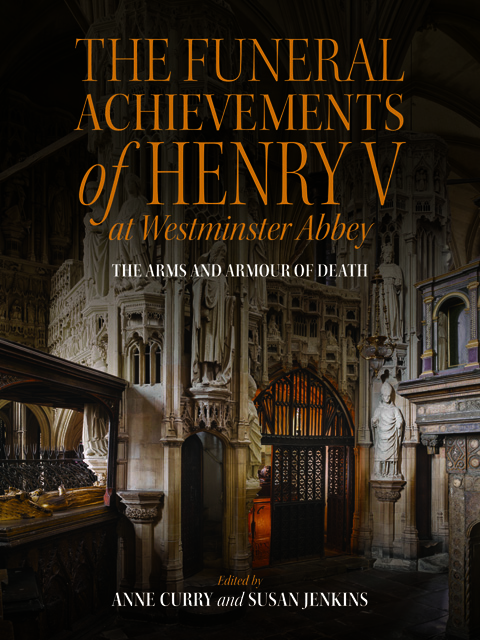Book contents
- Frontmatter
- Dedication
- Contents
- List of Illustrations
- List of Contributors
- Foreword
- Preface
- Acknowledgements
- List of Abbreviations
- 1 Introduction: Henry V and Westminster Abbey – Life, Death and Afterlife
- 2 Henry V’s Funeral Achievements in the Context of Westminster Abbey : ‘Trophies of this Warlike Prince’
- 3 The Funeral of Henry V
- 4 Henry V’s Chapel
- 5 The Funerary Helm of King Henry V : A Helm for the Joust of Peace, c. 1380–1420
- 6 A Saddle from the Funeral of Henry V
- 7 The Shield from the Funeral Achievements of Henry V
- 8 ‘Our bruisèd arms hung up for monuments’. The Sword of Henry V?
- 9 Conservation of the Funeral Achievements
- 10 Scientific Analysis: Micro-Invasive Techniques
- 11 Scientific Analysis: Non-Invasive Techniques
- Appendix: The Will of Henry V, 1421
- Index of People and Places
- Royal Armouries Research Series
4 - Henry V’s Chapel
Published online by Cambridge University Press: 11 January 2023
- Frontmatter
- Dedication
- Contents
- List of Illustrations
- List of Contributors
- Foreword
- Preface
- Acknowledgements
- List of Abbreviations
- 1 Introduction: Henry V and Westminster Abbey – Life, Death and Afterlife
- 2 Henry V’s Funeral Achievements in the Context of Westminster Abbey : ‘Trophies of this Warlike Prince’
- 3 The Funeral of Henry V
- 4 Henry V’s Chapel
- 5 The Funerary Helm of King Henry V : A Helm for the Joust of Peace, c. 1380–1420
- 6 A Saddle from the Funeral of Henry V
- 7 The Shield from the Funeral Achievements of Henry V
- 8 ‘Our bruisèd arms hung up for monuments’. The Sword of Henry V?
- 9 Conservation of the Funeral Achievements
- 10 Scientific Analysis: Micro-Invasive Techniques
- 11 Scientific Analysis: Non-Invasive Techniques
- Appendix: The Will of Henry V, 1421
- Index of People and Places
- Royal Armouries Research Series
Summary
Henry V’s chapel is one of the single most spectacular products of English fifteenthcentury architecture – a miniature and exquisitely detailed cage of stone that bridges the ambulatory of Westminster Abbey and the tomb of the king it memorialises (Fig. 4.1). Set on the central axis of this great church, it today forms a backdrop to the High Altar and is superbly well-preserved, replete with virtually its entire – and exceptionally large – collection of medieval sculpture. Only in this building, perhaps, where so many treasures and monuments vie for attention, could such an astonishing and important survival struggle for notice. Yet it has done so. In part that is because it was created between the episodes of Westminster’s history that have chiefly interested scholars. Also, because like so many structures designed by English masons working in the late Gothic idiom known as the Perpendicular, it falls awkwardly between the categories of furnishing and building. The extremely limited documentation relating to it has not helped either, nor the relative obscurity of its creator, and undoubted designer, the master mason John Crowche, alias Thirsk.
This chapter about the chapel takes as its point of departure the standard account of the monument and its sculpture published over a century ago in 1914 by W. H. St John Hope. This draws together nearly all the relevant documentary material and describes the whole in considerable detail.1 No less important is the more recent work of Antje Fehrmann on the funerary monuments of the Lancastrian dynasty. Her published doctorate is notable amongst other things for the exceptional series of illustrations that it assembles.2 The analysis here departs in some important points from that presented in both these studies. It falls into several sections, of which the first considers the king’s will – the essential starting point for a study of the chapel – and the context of his choice of burial at Westminster. The second looks at the design of the chapel and the career of the mason responsible for it, John Thirsk, as well as the operations of the king’s works, the body responsible for royal building projects and the promulgation of the Perpendicular style. There follows a brief consideration of the form of the Abbey church prior to the erection of the chapel and then a description and history of the tomb, its effigy and the chapel.
- Type
- Chapter
- Information
- The Funeral Achievements of Henry V at Westminster AbbeyThe Arms and Armour of Death, pp. 44 - 91Publisher: Boydell & BrewerPrint publication year: 2022

